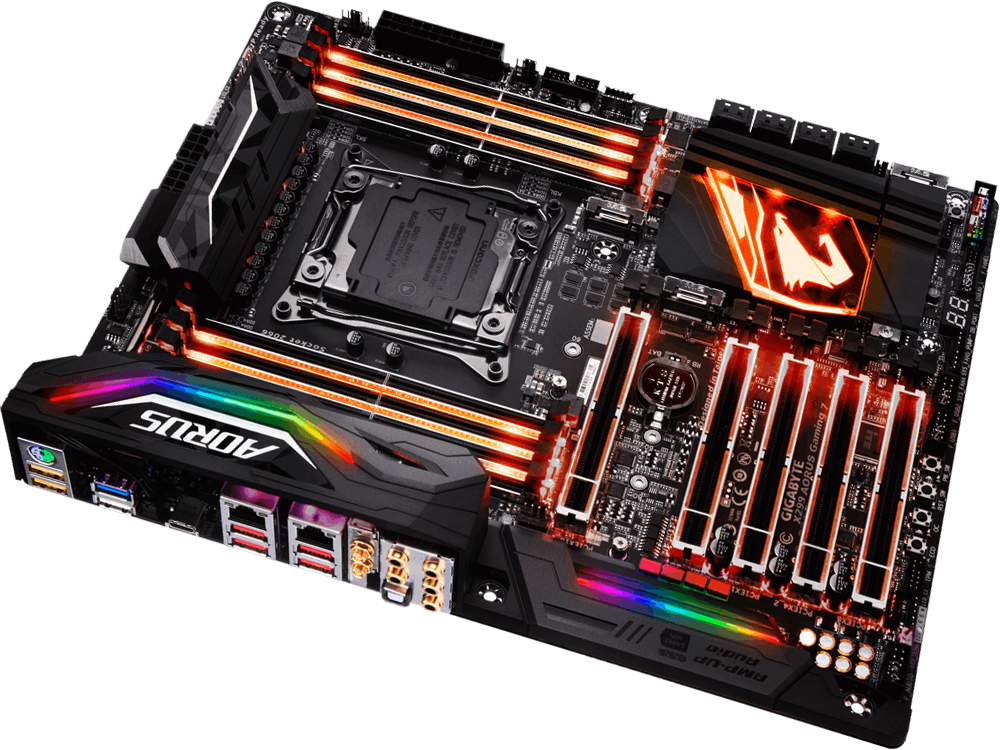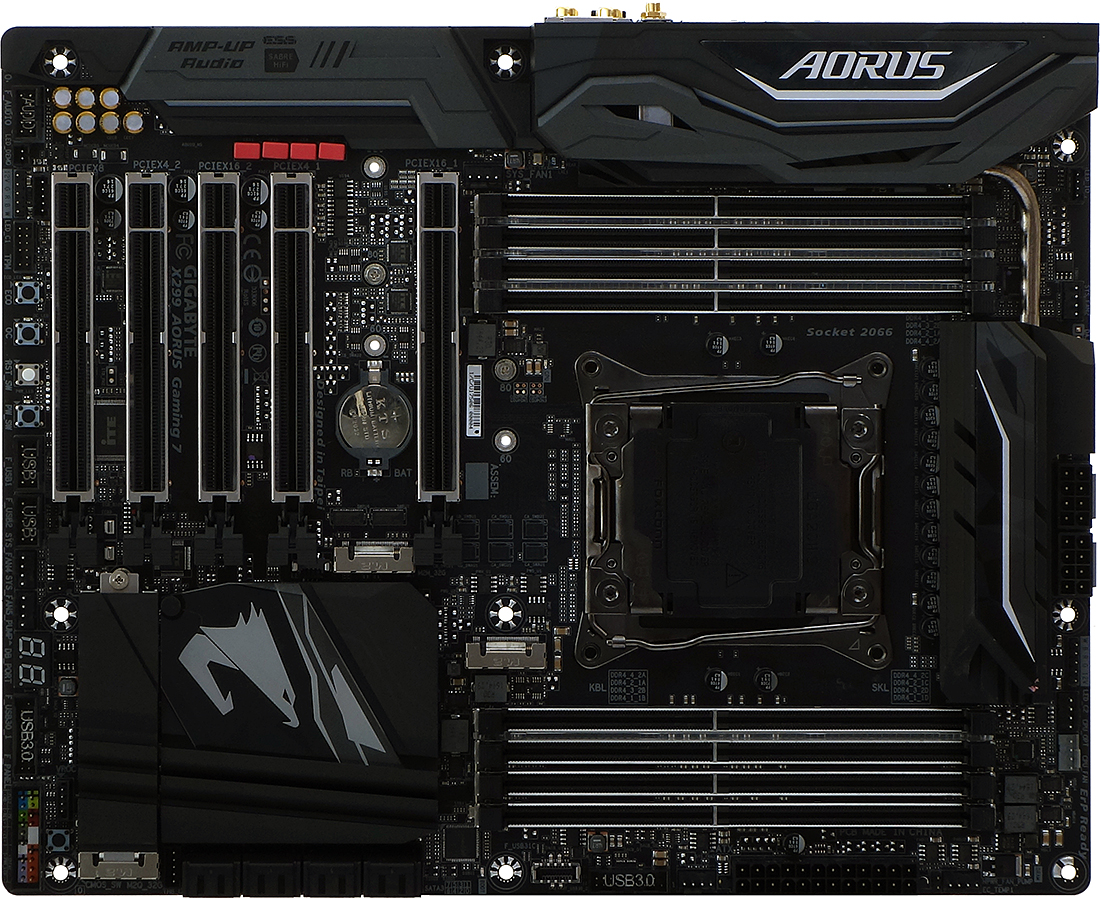Early Verdict
Had the X299 Aorus Gaming 7 included a Thunderbolt 3 controller, it would have easily won a higher award. Were we more concerned with energy efficiency, the X299 Aorus Gaming 7 wouldn’t have won any award. The X299 Aorus Gaming 7’s upscale components are probably worth the extra money for many buyers.
Pros
- +
Solid CPU Overclocking
- +
Upscale Wi-Fi and secondary Ethernet controllers
- +
Upscale audio components
- +
Elaborate, fully-functional RGB lighting
- +
Extra M.2 and four-lane PCIe slot
Cons
- -
Extra M.2 and PCIe slot share lanes
- -
No 0x AVX offset available on published firmware
- -
Mediocre memory overclocking
- -
Poor energy efficiency
Why you can trust Tom's Hardware
Features & Layout
From everything we’ve seen so far, the price for upgrading from a motherboard supporting Intel’s mainstream CPU to one that hosts its high-end desktop (aka HEDT) CPU is going to be around $100. For that, you can expect an extra layer of circuits and an extra ground layer to isolate them as PCIe lane count jumps from 16 to 44, and DRAM channels jump from two to four. That doesn’t necessarily sound like justification for the price increase, but we also have to remember that a slew of switches is needed for the same boards to support 28-lane and 16-lane CPUs without shutting off half the circuits. Oh, and even though there’s less room around the land grid for power circuitry, the combined total output needs to be around twice as high.
We’ve recently seen a $300 X299 board that was every bit the replacement for a $200 Z270. Let’s consider how (and why) the X299 Aorus Gaming 7 might be worth yet another Benjamin.
We could begin by just looking at Gigabyte’s promo images, which show that the X299 Aorus Gaming 7 has more RGB lighting than any of the other boards we’ve tested. LEDs line all five PCIe x16-length slots as well as all eight DIMM slots. But notice that we said all five x16-length slots, where competing models have had only four.
The X299 Aorus Gaming 7 matches its $300 rival by having an extra M.2 slot connected via CPU lanes, yet Gigabyte also gives users the option of directing those lanes to an expansion card. That just means you get either all five long expansion slots or three M.2 slots and four of those five expansion slots. Note that neither option is available on MSI’s $350 or Asus’s $490 parts, so at least we’ve found one way to narrow the field. Also, it must cost Gigabyte at least a few dollars to add the extra slot and switches to enable that option.
A higher-resolution photo of the actual board we received (click to enlarge, below) shows the I/O panel a little more clearly, with its Killer 1525 867 Mb/s Wi-Fi controller, which is a substantial upgrade from the $300 board’s old 433 Mb/s Intel part. An included Killer E2500 PCIe-based Gigabit Ethernet controller enables Killer DoubleShot Pro mode, although the use of an Intel PHY for the other Gigabit Ethernet controller excludes the widely-promoted Killer DoubleShot-X3 option.
Rear panel audio uses an ESS9018Q2C DAC, WIMA and Nichicon gold capacitors, and LME49720 op-amp, to maintain the highest possible analog output from the relatively common (but still high-end) ALC1220 codec.
Given Gigabyte’s previous commitment to Intel Thunderbolt technology, I’m personally a little disappointed to see the use of an ASM3142 controller for the USB Type-C port. That’s despite the ASMedia controller’s high-bandwidth PCIe 3.0 x2 connection. It’s fast, it’s just not Thunderbolt 3 fast.
Get Tom's Hardware's best news and in-depth reviews, straight to your inbox.
The other USB 3.1 Gen 2 port of ASMedia’s high-bandwidth controller goes to a Realtek hub, spreading its bandwidth across all four of the red-colored Type A connectors. That won’t be a problem for people who only access one high-bandwidth device at a time, but don’t expect multiple 10Gb/s devices to operate at peak performance simultaneously.
The remaining four I/O-panel USB ports are all 5Gb/s Type 1, and rely on a different USB hub to reduce reliance on chipset resources. The white one is designated for Gigabyte’s Q-Flash Plus automatic firmware updating, but forcing an error significant enough to engage the automated update function wasn’t easy: Only after removing the CPU from the socket did it work, flashing the backup as well as the main firmware from an image that had been renamed GIGABYTE.BIN on a FAT-format thumb drive.
Many companies put handy buttons on the I/O panel for functions such as CLR_CMOS, but some builders don’t like those because they’re too easy for observers to press. If you’re paying for this much lighting you’re probably going to want to show off, so Gigabyte instead put all the quick function buttons inside the case, meaning on the motherboard’s surface. The CLR_CMOS button is even moved away from all the other buttons to the board’s forward bottom corner to prevent accidental deployment by the actual owner. And the four other buttons provide Economy mode, OC mode, Rest, and Power function. The programed O/C for our Core i9-7900X is 4.7 GHz at around 1.22V CPU core (under load).
Builders of 3-way SLI or CrossFireX will find the bottom slot most appropriate for a third card, due to the eight pathways available when using 44-lane or 28-lane processors. Unfortunately, putting a high-end card in that slot means giving up the lower USB 3.0 header, since the appropriate cables are too stiff to fold under a card. Fortunately, the X299 Aorus Gaming 7 has another USB 3.0 header just above the center of the front edge, plus a newer Gen 2 port for new generation cases that have true 10Gb/s Type-C ports.
In addition to a plethora of obvious but small feature enhancements, less obvious is the 2-amp Digital LED output, which works in concert with two RGBW headers that extend the X299 Aorus Gaming 7’s top-end onboard lighting to external components. Other not-so-obvious improvements include its provision of eight 4-pin fan headers, which are all configurable between PWM and voltage control modes, and two 8-pin (rather than 8+4-pin) CPU power connectors.
The X299 Aorus Gaming 7 installation kit includes a Wi-Fi antenna and retention cover, documentation, a driver and applications disc, a G-Connector bundler for front-panel LED/power/reset connectors, a case badge, two Velcro cable ties, four SATA cables, a digital LED extension cable, an RGB-lighted I/O shield, two RGBW strip extension cables, an HB-SLI bridge, two thermistor cables, and a giant sheet of stickers. There is no 3-way SLI bridge, since Nvidia doesn’t support this mode with its most recent graphics cards.
MORE: Best Motherboards
MORE: How To Choose A Motherboard
MORE: All Motherboard Content
-
drwho1 I'm still hoping that future boards don't limit features on their boards. I don't want to see "if you used m.2 drive you loose 2 Sata connections " anymore... then this boards with 2 or 3 m.2 if you used them, then you lose 4/6 Sata connections out of 8?Reply
Just not make sense to me. -
AgentLozen ReplyDrWho1 said:I'm still hoping that future boards don't limit features on their boards. I don't want to see "if you used m.2 drive you loose 2 Sata connections " anymore... then this boards with 2 or 3 m.2 if you used them, then you lose 4/6 Sata connections out of 8?
Just not make sense to me.
I understand why you would say this. I also think that every feature on a motherboard should be 100% usable.
What's happening though is that there are more features on the board than there is bandwidth for it. If you enable one feature, it eats the resources needed for another. Have you ever worked at a job that was understaffed? It's like that. -
What i like about x299 platform is that PCIe frequency just like with 1366 socket is not affected when you change BLCK. I wish it is the same case for X99, would make possible to overclock Xeons easily.Reply
-
This price is too much. Waiting for < $200 X399 AMD or X299 Intel and they will come in about year.Reply
-
Kahless01 until intel quits screwing around and comes up with a decent plan instead of playing it fast and loose there is really no reason to test any of its products. there are far too many variables because of the rush job they did. youre just going to have to retest when they come to their senses and thats a lot of wasted time and resources on everyones part.Reply -
derekullo Reply19961930 said:GOD THE LIGHTING IS SO TACKY
Red lights make it faster.
PC Building 101
-
gasaraki Reply19961735 said:until intel quits screwing around and comes up with a decent plan instead of playing it fast and loose there is really no reason to test any of its products. there are far too many variables because of the rush job they did. youre just going to have to retest when they come to their senses and thats a lot of wasted time and resources on everyones part.
So you mean just like Ryzen boards? If everyone followed your advice, there wouldn't be any motherboard reviews for either brands.
-
AnimeMania Does anybody know if it is "OK" to put your graphics card in any of the 5 PCIe slots on the motherboard. I would probably place my graphics card in the PCIe slot farthest from the CPU so as not to cover up the LED graphics and provide adequate ventilation. Something in the back of my mind tells me that not all PCIe slots are equal and you might be penalized for doing so.Reply





